形容词和副词比较级和最高级用法口诀
形容词及副词的比较级和最高级的用法

比较级和最高级一、形容词比较级和最高级的规则其它不规则的变化:二、形容词比较级基本用法1、与than搭配的基本形式(1)名词/代词He is older than me.(2) 动名词/从句Skiing is more exciting than skating.(3) 状语/动词/形容词/副词①much/a lot/ a bit/ a little/ slightly/any/ no/ even/ some/ stillEg: She is feeling a lot/much better today.Do you feel any better today?She is no older than mike.②数词My sister is ten years younger than me.2、特殊搭配1)“比较级+and+比较级”表示“越来越……”eg: He becomes fatter and fatter. She is growing more and more beautiful2)“The +比较级…,the +比较级”表示“越……,越……”The busier he is ,the happier he feels3)表示两者中”较……“时,用the + 形容词比较级+ of 短语来表达。
He is the taller of the two.4)在含有or的选择疑问句中,如果有两者供选择,前面的形容词要用比较级形式。
5)More ...than...的几种用法和含义①more B than A = less A than B. He is more lazy than slow at his work= he is less slow than lazy at his work.②no/not any more/less… than…两个都不(neither)③More than不仅仅是,no Less than(不)少于,more or less 差不多The work is more or less finished.one more=another more Any other+名词单数(名词可以省略)3、修饰比较级的词①a bit, a little, rather, much,far, by far, many, a lot, lots, a great deal, any, still, even(very只修饰原级)②用表示倍数的词或度量名词作修饰语。
英语形容词和副词的比较级和最高级
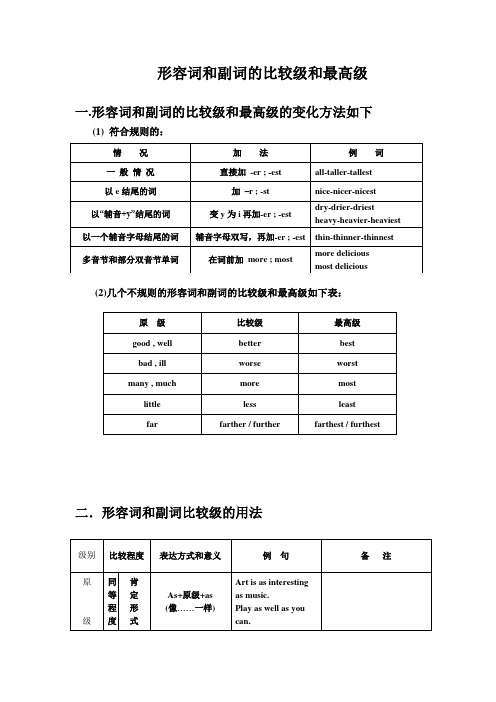
形容词和副词的比较级和最高级一.形容词和副词的比较级和最高级的变化方法如下(1) 符合规则的:(2)几个不规则的形容词和副词的比较级和最高级如下表:二.形容词和副词比较级的用法注意:有些形容词,如 dead, empty, round, sure, woolen 等受本身含义的限制,没有比较级。
例题解析1. He is ________ friends than I.A. much moreB. many moreC. very moreD. too more解析:后面有可数名词复数时,many的比较级形式为many more 修饰。
应选B.2. Which is the _________ country, Japan or Australia?A. more developedB. more developingC. most developedD. most developing解析:两者比较用比较级,表示"发达"用developed, 而developing 是"发展中的" 意思3. There were _______ shops in the city in 1982 than in 1990.A. littleB. fewC. fewerD. less解析:little 不能修饰可数名词,两者比较需用比较级,所以应选C.4. If you are not free today, come another day __________.A. tooB. soC. insteadD. yet解析:instead 作副词用时意为"代替,顶替",表示前面的事情没做,而是做了后面的事。
Instead一般位于句首。
应选C.5.He can't tell us ________, I think.A. important anythingB. anything importantC. important somethingD. something important.解析:不定代词与形容词联用需后置,否定句中应该用anything而不是something. 因此应选B6. The Huang River is the second __________ river in our country.A. longB. longerC. longestD. the longest解析:"定冠词the+ 序数词+ 形容词最高级" 表示"第几大……" 应选C.7. The light in the office wasn't ________for him to read.A. enough brightB. bright enoughC. brightlyD. enough brightly解析:enough修饰名词时可前可后,修饰形容词或副词时,要后置。
形容词和副词的用法口诀
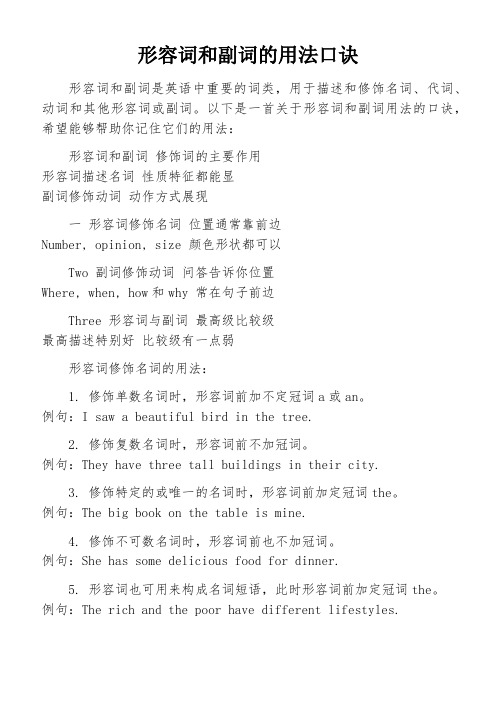
形容词和副词的用法口诀形容词和副词是英语中重要的词类,用于描述和修饰名词、代词、动词和其他形容词或副词。
以下是一首关于形容词和副词用法的口诀,希望能够帮助你记住它们的用法:形容词和副词修饰词的主要作用形容词描述名词性质特征都能显副词修饰动词动作方式展现一形容词修饰名词位置通常靠前边Number, opinion, size 颜色形状都可以Two 副词修饰动词问答告诉你位置Where, when, how和why 常在句子前边Three 形容词与副词最高级比较级最高描述特别好比较级有一点弱形容词修饰名词的用法:1. 修饰单数名词时,形容词前加不定冠词a或an。
例句:I saw a beautiful bird in the tree.2. 修饰复数名词时,形容词前不加冠词。
例句:They have three tall buildings in their city.3. 修饰特定的或唯一的名词时,形容词前加定冠词the。
例句:The big book on the table is mine.4. 修饰不可数名词时,形容词前也不加冠词。
例句:She has some delicious food for dinner.5. 形容词也可用来构成名词短语,此时形容词前加定冠词the。
例句:The rich and the poor have different lifestyles.6. 形容词还可以加上后缀-er和-est构成比较级和最高级形式。
例句:She is taller than her sister. (比较级)He is the tallest boy in the class. (最高级)副词修饰动词的用法:1. 副词通常放在动词之后。
例句:He runs quickly in the morning.2. 若要强调副词修饰的是动作的方式,将副词置于句首。
例句:Quickly, he finished his homework.3. 副词也可以修饰整个句子,放在句子前或句子末。
形容词和副词比较级和最高级的用法归纳

形容词和副词比较级和最高级一形容词、副词的比较级和最高级的构成规则:1一般情况加-er, -est tall→taller→tallest great→greater→greatest 2以不发音e结尾的单音节词加-r,-st large→larger→largest nice→nicer→nicest3在重读闭音节(即:辅音+元音+辅音)中,先双写末尾的辅音字母再加-er, -estbig→bigger→biggesthot→hotter→hottest4以“辅音字母+y”结尾的双音节词,把y改为i再加-er, -esteasy→easier→easiestheavy→heavier→heaviest, lucky-luckier5以ow,er结尾的双音节词加-er, -est clever→cleverer→cleverestnarrow→narrower→narrowest6其他双音节词(副词)和多音节词,比较级在前面加more,最高级在前面加mostbeautiful→more beautiful→most beautifuldifferent→more different→most differenteasily→more easily→most easilyfriendly—more friendly; common—more common; helpful—morehelpful,more careful, more nervous, more relaxed, more normal,modern-more modernunhappy—more unhappy, unlucky—more unlucky注:最高级前要加the ,不加表示“非常”,a most important meeting副词的比较级和最高级1.大多数以ly结尾的副词前加more 和most 来构成比较级和最高级。
初中英语语法形容词和副词的比较级和最高级简单记法
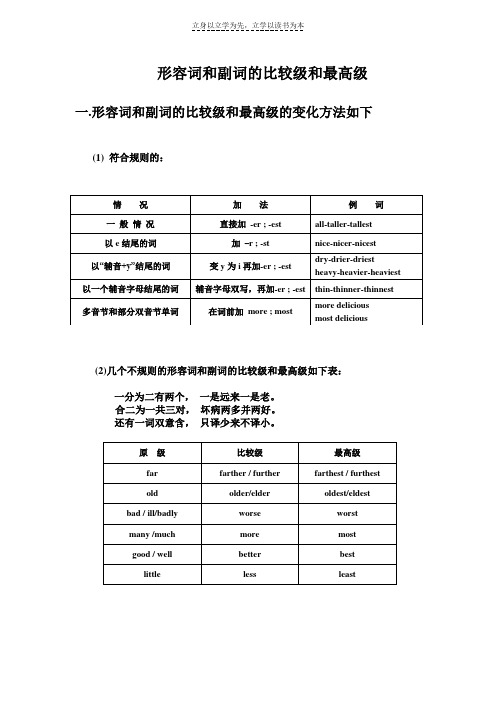
形容词和副词的比较级和最高级一.形容词和副词的比较级和最高级的变化方法如下(1) 符合规则的:(2)几个不规则的形容词和副词的比较级和最高级如下表:一分为二有两个,一是远来一是老。
合二为一共三对,坏病两多并两好。
还有一词双意含,只译少来不译小。
二.形容词和副词比较级的用法注意:有些形容词,如dead, empty, round, sure, woolen等受本身含义的限制,没有比较级。
例题解析1. He is ________ friends than I.A. much moreB. many moreC. very moreD. too more解析:后面有可数名词复数时,many的比较级形式为many more 修饰。
应选B.2. Which is the _________ country, Japan or Australia?A. more developedB. more developingC. most developedD. most developing解析:两者比较用比较级,表示"发达"用developed, 而developing 是"发展中的" 意思3. There were _______ shops in the city in 1982 than in 1990.A. littleB. fewC. fewerD. less解析:little 不能修饰可数名词,两者比较需用比较级,所以应选C.4. If you are not free today, come another day __________.A. tooB. soC. insteadD. yet解析:instead 作副词用时意为"代替,顶替",表示前面的事情没做,而是做了后面的事。
Instead一般位于句首。
应选C.5.He can't tell us ________, I think.A. important anythingB. anything importantC. important somethingD. something important.解析:不定代词与形容词联用需后置,否定句中应该用anything而不是something. 因此应选B6. The Huang River is the second __________ river in our country.A. longB. longerC. longestD. the longest解析:"定冠词the+ 序数词+ 形容词最高级" 表示"第几大……" 应选C.7. The light in the office wasn't ________for him to read.A. enough brightB. bright enoughC. brightlyD. enough brightly解析:enough修饰名词时可前可后,修饰形容词或副词时,要后置。
副词形容词比较级最高级小口诀
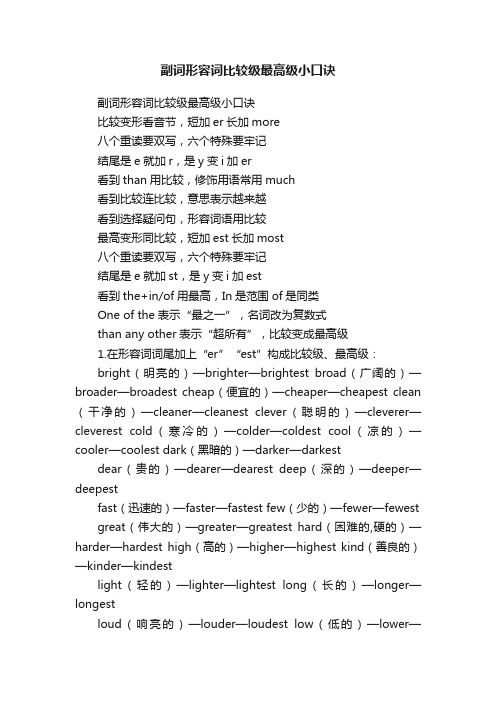
副词形容词比较级最高级小口诀副词形容词比较级最高级小口诀比较变形看音节,短加er长加more八个重读要双写,六个特殊要牢记结尾是e就加r,是y变i加er看到than用比较,修饰用语常用much看到比较连比较,意思表示越来越看到选择疑问句,形容词语用比较最高变形同比较,短加est长加most八个重读要双写,六个特殊要牢记结尾是e就加st,是y变i加est看到the+in/of用最高,In是范围of是同类One of the表示“最之一”,名词改为复数式than any other表示“超所有”,比较变成最高级1.在形容词词尾加上“er”“est”构成比较级、最高级:bright(明亮的)—brighter—brightest broad(广阔的)—broader—broadest cheap(便宜的)—cheaper—cheapest clean (干净的)—cleaner—cleanest clever(聪明的)—cleverer—cleverest cold(寒冷的)—colder—coldest cool(凉的)—cooler—coolest dark(黑暗的)—darker—darkestdear(贵的)—dearer—dearest deep(深的)—deeper—deepestfast(迅速的)—faster—fastest few(少的)—fewer—fewest great(伟大的)—greater—greatest hard(困难的,硬的)—harder—hardest high(高的)—higher—highest kind(善良的)—kinder—kindestlight(轻的)—lighter—lightest long(长的)—longer—longestloud(响亮的)—louder—loudest low(低的)—lower—lowestnear(近的)—nearer—nearest new(新的)—newer—newestpoor(穷的)—poorer—poorest quick(快的)—quicker—quickestquiet(安静的)—quieter—quietest rich(富裕的)—richer—richestshort(短的)—shorter—shortest slow(慢的)—slower—slowestsmall(小的)—smaller—smallest smart(聪明的)—smarter—smartest soft(柔软的)—softer—softest strong(强壮的)—stronger—strongest sweet(甜的)—sweeter—sweetest tall(高的)-taller-tallestthick(厚的)—thicker—thickest warm(温暖的)—warmer—warmest weak(弱的)—weaker—weakest young(年轻的)—younger—youngest 2.双写最后一个字母,再加上“er”“est”构成比较级、最高级:big(大的)—bigger—biggest fat(胖的)—fatter—fattesthot(热的)—hotter—hottest red(红的)—redder—reddestsad(伤心的)—sadder—saddest thin(瘦的)—thinner—thinnestwet(湿的)—wetter—wettest mad(疯的)—madder—maddest3.以不发音的字母e结尾的形容词,加上“r”、“st”构成比较级、最高级:able(能干的)—abler—ablest brave(勇敢的)—braver—bravestclose(接近的)—closer—closest fine(好的,完美的)—finer—finestlarge(巨大的)—larger—largest late(迟的)—later—latestnice(好的)—nicer—nicest ripe(成熟的)—riper—ripestrude(粗鲁的)—ruder—rudest safe(安全的)—safer—safeststrange(奇怪的)—stranger—strangest wide(宽广的)—wider—widestwise(睿智的,聪明的)—wiser—wisest white(白的)—whiter—whitest4.以字母y结尾的形容词,把y改为i,再加上“er”、“est”构成比较级、最高级:busy(忙碌的)—busier—busiest dirty(脏的)—dirtier—dirtiestdry(干燥的)—drier—driest early(早的)—earlier—earliesteasy(容易的)—easier—easiest friendly(友好的)—friendlier—friendliestfunny(好玩的)—funnier—funniest happy(开心的)—happier—happiest healthy(健康的)—healthier—healthiest heavy(重的)—heavier—heaviest hungry(饿的)—hungrier—hungriest lazy(懒惰的)—lazier—laziestlucky(幸运的)—luckier—luckiest naughty(调皮的)—naughtier—naughtiest noisy(嘈杂的)—noisier—noisiest pretty (美丽的)—prettier—prettiestsilly(傻的)—sillier—silliest spicy(辣的)—spicier—spiciest thirsty(渴的)—thirstier—thirstiest ugly(丑的)—uglier—ugliest5.双音节、多音节形容词,在单词前面加上“more”“most”构成比较级、最高级:afraid(害怕的)—more afraid—most afraid beautiful(美丽的)—more beautiful—most beautifulcareful(仔细的)—more careful—most carefulcheerful(开心的)—more cheerful—most cheerfulcrowded(拥挤的)—more crowded—most crowdeddangerous(危险的)—more dangerous—most dangerous delicious(美味的)—more delicious—most deliciousdifficult(困难的)—more difficult—most difficultexciting(令人兴奋的)—more exciting—most excitingexpensive(昂贵的)—more expensive—most expensivefamous(著名的)—more famous—most famousfrightened(受惊的)—more frightened—most frightened frightening(令人害怕的)—more frightening—most frighteninghard-working(勤奋的)—more hard-working—most hard-workinghelpful(有帮助的)—more helpful—most helpfulhonest(诚实的)—more honest—most honestimportant(重要的)—more important—most importantinteresting(有趣的)—more interesting—most interesting polite(有礼貌的)—more polite—most politeterrible(可怕的)—more terrible—most terribletired(累的)—more tired—most tired6.不规则变化的形容词:good(好的)/ well(好的)—better—bestbad(坏的)/ badly(坏的)/ ill(病的)—worse—worstmany(多的)/ much(多的)—more—mostlittle(少的)—less—leastold(老的)—older/ elder—oldest/ eldestfar(远的)—farther/ further—farthest furthest。
英语比较级和最高级的用法归纳
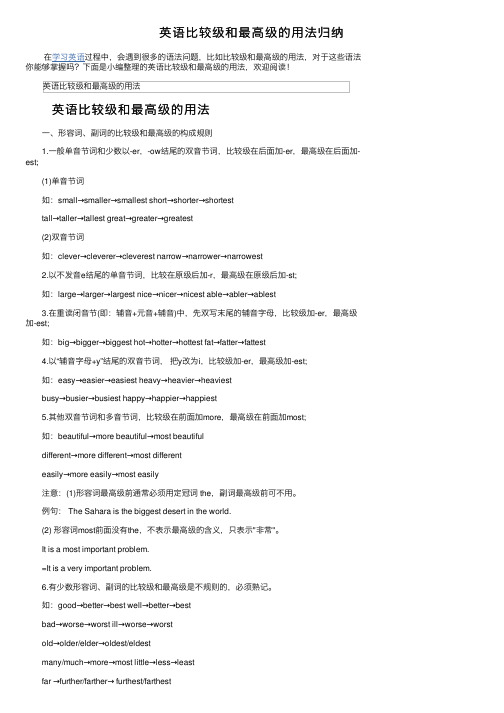
英语⽐较级和最⾼级的⽤法归纳 在学习英语过程中,会遇到很多的语法问题,⽐如⽐较级和最⾼级的⽤法,对于这些语法你能够掌握吗?下⾯是⼩编整理的英语⽐较级和最⾼级的⽤法,欢迎阅读!英语⽐较级和最⾼级的⽤法 英语⽐较级和最⾼级的⽤法 ⼀、形容词、副词的⽐较级和最⾼级的构成规则 1.⼀般单⾳节词和少数以-er,-ow结尾的双⾳节词,⽐较级在后⾯加-er,最⾼级在后⾯加-est; (1)单⾳节词 如:small→smaller→smallest short→shorter→shortest tall→taller→tallest great→greater→greatest (2)双⾳节词 如:clever→cleverer→cleverest narrow→narrower→narrowest 2.以不发⾳e结尾的单⾳节词,⽐较在原级后加-r,最⾼级在原级后加-st; 如:large→larger→largest nice→nicer→nicest able→abler→ablest 3.在重读闭⾳节(即:辅⾳+元⾳+辅⾳)中,先双写末尾的辅⾳字母,⽐较级加-er,最⾼级加-est; 如:big→bigger→biggest hot→hotter→hottest fat→fatter→fattest 4.以“辅⾳字母+y”结尾的双⾳节词,把y改为i,⽐较级加-er,最⾼级加-est; 如:easy→easier→easiest heavy→heavier→heaviest busy→busier→busiest happy→happier→happiest 5.其他双⾳节词和多⾳节词,⽐较级在前⾯加more,最⾼级在前⾯加most; 如:beautiful→more beautiful→most beautiful different→more different→most different easily→more easily→most easily 注意:(1)形容词最⾼级前通常必须⽤定冠词 the,副词最⾼级前可不⽤。
形容词副词比较级和最高级用法总结
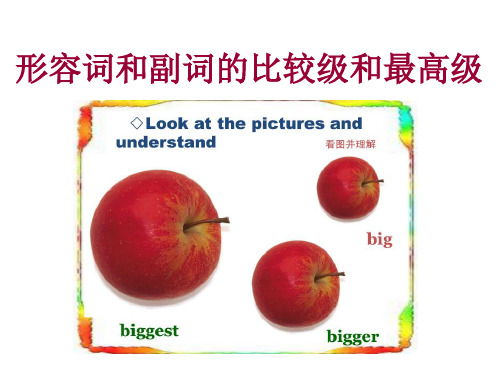
1. 写出下列形容词的比较级和最高级
(1)ill/bad /badly worse--worst busier--busiest (2)busy (3)big bigger--biggest (4)rude ruder--rudest hotter--hottest (5)hot easier--easiest (6)easy less--least (7)little more careful--most careful (8)careful farther/further--farthest/furthest (9)far (10)quiet quieter/more quiet--quietest/most quiet
⑤多音节词或部分双音节词的比较级和
最高级在其前面加more或most。
beautiful —more beautiful—most beautiful important —more important—most important Interesting– more interesting– most interesting quickly – more quickly – most quickly
他在班里,比任何学生都好。(他是最好的) 制 He is better than any other student in the class. 作 (He is the best student in the class. )
人 : 彭 险 峰
11、 the + 比较级 + of the two 两个中比较……的
2、不规则形容词的比较级最高级
原 级 good / well好的 many / much许多 little 少的 ill / bad / badly 坏的,差的 far 远的 old 老的 比较级
形容词和副词的比较级和最高级(完美版)
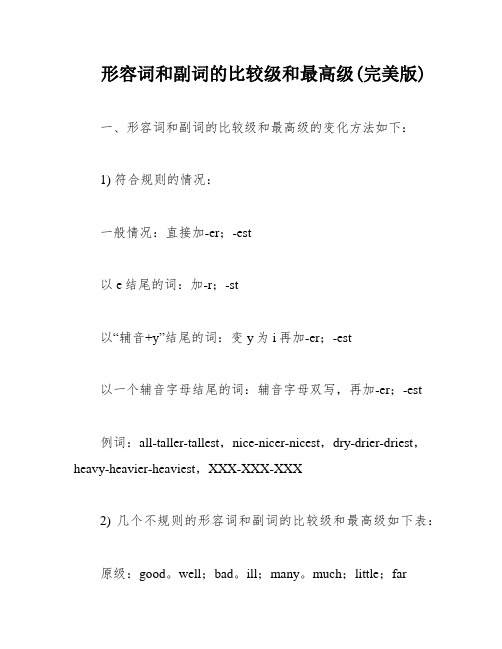
形容词和副词的比较级和最高级(完美版)一、形容词和副词的比较级和最高级的变化方法如下:1) 符合规则的情况:一般情况:直接加-er;-est以e结尾的词:加-r;-st以“辅音+y”结尾的词:变y为i再加-er;-est以一个辅音字母结尾的词:辅音字母双写,再加-er;-est例词:all-taller-tallest,nice-nicer-nicest,dry-drier-driest,heavy-heavier-heaviest,XXX-XXX-XXX2) 几个不规则的形容词和副词的比较级和最高级如下表:原级:good。
well;bad。
ill;many。
much;little;far二、形容词和副词比较级的用法:级别比较程度肯定表达方式和意义例句(备注)原级同等程度 As+原级+as (像……一样) XXX。
not + so (as) +原级+as (不如……那样) English is not so difficult as science。
比较级不同程度 (用于两者比较) 比较级+than (比……) XXX XXX。
比较级前面可以加much。
far。
even。
still。
a lot。
a little。
a bit等程度加深 I like pork better than beef。
最高级同一范围内的最高程度 The +比较级,the +比较级(越……,越……) XXX gets。
the XXX.The XXX reads。
the better their XXX。
This is because reading can XXX.The highest degree of something is expressed using the superlative form。
which is used for three or more things。
Forexample。
"Spring is the best season of the year." Another example is "Lin Tao jumped the farthest of all."When using the superlative form with an adverb。
副词形容词比较级最高级小口诀

副词形容词比较级最高级小口诀比较变形看音节,短加er长加more八个重读要双写,六个特殊要牢记结尾是e就加r,是y变i加er看到than用比较,修饰用语常用much看到比较连比较,意思表示越来越看到选择疑问句,形容词语用比较最高变形同比较,短加est长加most八个重读要双写,六个特殊要牢记结尾是e就加st,是y变i加est看到the+in/of用最高,In是范围of是同类One of the表示“最之一”,名词改为复数式than any other表示“超所有”,比较变成最高级1.在形容词词尾加上“er”“est”构成比较级、最高级:bright(明亮的)—brighter—brightest broad(广阔的)—broader—broadest cheap(便宜的)—cheaper—cheapest clean(干净的)—cleaner—cleanest clever(聪明的)—cleverer—cleverest cold(寒冷的)—colder—coldest cool(凉的)—cooler—coolest dark(黑暗的)—darker—darkestdear(贵的)—dearer—dearest deep(深的)—deeper—deepestfast(迅速的)—faster—fastest few(少的)—fewer—fewestgreat(伟大的)—greater—greatest hard(困难的,硬的)—harder—hardest high(高的)—higher—highest kind(善良的)—kinder—kindestlight(轻的)—lighter—lightest long(长的)—longer—longestloud(响亮的)—louder—loudest low(低的)—lower—lowestnear(近的)—nearer—nearest new(新的)—newer—newestpoor(穷的)—poorer—poorest quick(快的)—quicker—quickestquiet(安静的)—quieter—quietest rich(富裕的)—richer—richestshort(短的)—shorter—shortest slow(慢的)—slower—slowestsmall(小的)—smaller—smallest smart(聪明的)—smarter—smartest soft(柔软的)—softer—softest strong(强壮的)—stronger—strongest sweet(甜的)—sweeter—sweetest tall(高的)-taller-tallestthick(厚的)—thicker—thickest warm(温暖的)—warmer—warmest weak(弱的)—weaker—weakest young(年轻的)—younger—youngest 2.双写最后一个字母,再加上“er”“est”构成比较级、最高级:big(大的)—bigger—biggest fat(胖的)—fatter—fattesthot(热的)—hotter—hottest red(红的)—redder—reddestsad(伤心的)—sadder—saddest thin(瘦的)—thinner—thinnestwet(湿的)—wetter—wettest mad(疯的)—madder—maddest3.以不发音的字母e结尾的形容词,加上“r”、“st”构成比较级、最高级:able(能干的)—abler—ablest brave(勇敢的)—braver—bravestclose(接近的)—closer—closest fine(好的,完美的)—finer—finestlarge(巨大的)—larger—largest late(迟的)—later—latestnice(好的)—nicer—nicest ripe(成熟的)—riper—ripestrude(粗鲁的)—ruder—rudest safe(安全的)—safer—safeststrange(奇怪的)—stranger—strangest wide(宽广的)—wider—widestwise(睿智的,聪明的)—wiser—wisest white(白的)—whiter—whitest4.以字母y结尾的形容词,把y改为i,再加上“er”、“est”构成比较级、最高级:busy(忙碌的)—busier—busiest dirty(脏的)—dirtier—dirtiestdry(干燥的)—drier—driest early(早的)—earlier—earliesteasy(容易的)—easier—easiest friendly(友好的)—friendlier—friendliestfunny(好玩的)—funnier—funniest happy(开心的)—happier—happiest healthy(健康的)—healthier—healthiest heavy(重的)—heavier—heaviest hungry(饿的)—hungrier—hungriest lazy(懒惰的)—lazier—laziestlucky(幸运的)—luckier—luckiest naughty(调皮的)—naughtier—naughtiest noisy(嘈杂的)—noisier—noisiest pretty(美丽的)—prettier—prettiestsilly(傻的)—sillier—silliest spicy(辣的)—spicier—spiciestthirsty(渴的)—thirstier—thirstiest ugly(丑的)—uglier—ugliest5.双音节、多音节形容词,在单词前面加上“more”“most”构成比较级、最高级:afraid(害怕的)—more afraid—most afraidbeautiful(美丽的)—more beautiful—most beautifulcareful(仔细的)—more careful—most carefulcheerful(开心的)—more cheerful—most cheerfulcrowded(拥挤的)—more crowded—most crowdeddangerous(危险的)—more dangerous—most dangerousdelicious(美味的)—more delicious—most deliciousdifficult(困难的)—more difficult—most difficultexciting(令人兴奋的)—more exciting—most excitingexpensive(昂贵的)—more expensive—most expensivefamous(著名的)—more famous—most famousfrightened(受惊的)—more frightened—most frightenedfrightening(令人害怕的)—more frightening—most frighteninghard-working(勤奋的)—more hard-working—most hard-workinghelpful(有帮助的)—more helpful—most helpfulhonest(诚实的)—more honest—most honestimportant(重要的)—more important—most importantinteresting(有趣的)—more interesting—most interestingpolite(有礼貌的)—more polite—most politeterrible(可怕的)—more terrible—most terribletired(累的)—more tired—most tired6.不规则变化的形容词:good(好的)/ well(好的)—better—bestbad(坏的)/ badly(坏的)/ ill(病的)—worse—worstmany(多的)/ much(多的)—more—mostlittle(少的)—less—leastold(老的)—older/ elder—oldest/ eldestfar(远的)—farther/ further—farthest furthest。
形容词和副词的比较级与最高级
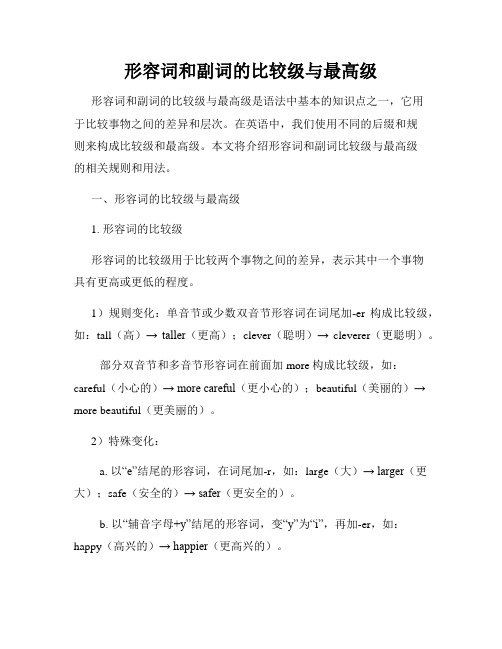
形容词和副词的比较级与最高级形容词和副词的比较级与最高级是语法中基本的知识点之一,它用于比较事物之间的差异和层次。
在英语中,我们使用不同的后缀和规则来构成比较级和最高级。
本文将介绍形容词和副词比较级与最高级的相关规则和用法。
一、形容词的比较级与最高级1. 形容词的比较级形容词的比较级用于比较两个事物之间的差异,表示其中一个事物具有更高或更低的程度。
1)规则变化:单音节或少数双音节形容词在词尾加-er构成比较级,如:tall(高)→ taller(更高);clever(聪明)→ cleverer(更聪明)。
部分双音节和多音节形容词在前面加more构成比较级,如:careful(小心的)→ more careful(更小心的);beautiful(美丽的)→ more beautiful(更美丽的)。
2)特殊变化:a. 以“e”结尾的形容词,在词尾加-r,如:large(大)→ larger(更大);safe(安全的)→ safer(更安全的)。
b. 以“辅音字母+y”结尾的形容词,变“y”为“i”,再加-er,如:happy(高兴的)→ happier(更高兴的)。
c. 部分以“辅音字母+元音字母+辅音字母”结尾的形容词,双写最后一个辅音字母,再加-er,如:big(大)→ bigger(更大)。
2. 形容词的最高级形容词的最高级用于比较三个或三个以上事物之间的差异,表示其中一个事物具有最高或最低的程度。
1)规则变化:在比较级的基础上,加上最前面加the,再加上-est构成最高级,如:tall(高)→ the tallest(最高的);clever(聪明)→ the cleverest(最聪明的)。
部分双音节和多音节形容词在前面加the most构成最高级,如:careful(小心的)→ the most careful(最小心的);beautiful(美丽的)→ the most beautiful(最美丽的)。
形容词和副词比较级和最高级的用法归纳
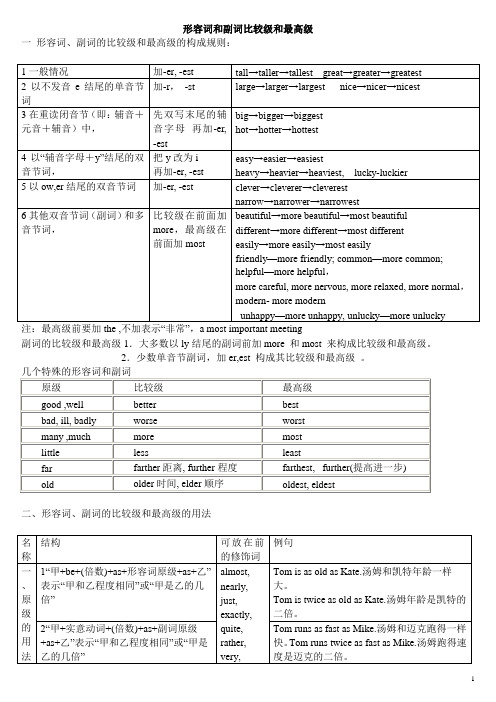
原级
比较级
最高级
good ,well
better
best
bad, ill, badly
worse
worst
many ,much
more
most
little
less
least
far
farther距离, further程度
farthest, further(提高进一步)
old
older时间, elder顺序
9“特殊疑问词+实意动词+副词比较级,甲or乙?”
Who draws better,Jenny or Danny?谁画得比较好,詹妮还是丹尼?
三、最高级常用句型结构
1“主语+be+the+形容词最高级+单数名词+in/of短语”表示“……是……中最……的”。
Tom is the tallest in his class./of all the students.汤姆是他们班上/所有学生当中最高的。
Mike gets to school earlier than any other student in his class.= Mike gets to school earlier than any of the other students in his class.注意:Mike gets to school earlier than any student in Tom’s class.迈克比汤姆班上任何一个学生到校都早。(迈克和汤姆不是同一个班)
unhappy—more unhappy,nlucky—more unlucky
注:最高级前要加the ,不加表示“非常”,a most important meeting
形容词和副词的比较级,最高级
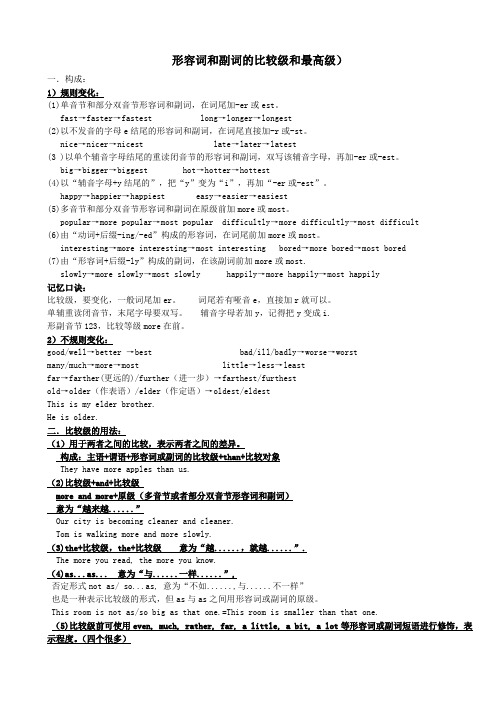
形容词和副词的比较级和最高级)一.构成:1)规则变化:(1)单音节和部分双音节形容词和副词,在词尾加-er或est。
fast→faster→fastest long→longer→longest(2)以不发音的字母e结尾的形容词和副词,在词尾直接加-r或-st。
nice→nicer→nicest late→later→latest(3 )以单个辅音字母结尾的重读闭音节的形容词和副词,双写该辅音字母,再加-er或-est。
big→bigger→biggest hot→hotter→hottest(4)以“辅音字母+y结尾的”,把“y”变为“i”,再加“-er或-est”。
happy→happier→happiest easy→easier→easiest(5)多音节和部分双音节形容词和副词在原级前加more或most。
popular→more popular→most popular difficultly→more difficultly→most difficu lt(6)由“动词+后缀-ing/-ed”构成的形容词,在词尾前加more或most。
interesting→more interesting→most interesting bored→more bored→most bored(7)由“形容词+后缀-ly”构成的副词,在该副词前加more或most.slowly→more slowly→most slowly happily→more happily→most happily记忆口诀:比较级,要变化,一般词尾加er。
词尾若有哑音e,直接加r就可以。
单辅重读闭音节,末尾字母要双写。
辅音字母若加y,记得把y变成i.形副音节123,比较等级more在前。
2)不规则变化:good/well→better →best bad/ill/badly→worse→worstmany/much→more→most little→less→leastfar→farther(更远的)/further(进一步)→farthest/furthestold→older(作表语)/elder(作定语)→oldest/eldestThis is my elder brother.He is older.二.比较级的用法:(1)用于两者之间的比较,表示两者之间的差异。
英语语法形容词和副词的比较级和最高级简单记法

合二为一共三对,坏病两多并两好。
还有一词双意含,只译少来不译小。
原级
比较级
最高级
far
farther / further
farthest / furthest
old
older/elder
oldest/eldest
bad /ill/badly
worse
worst
many /much
Lin Tao jumped (the) farthest of all.
副词最高级前面的
the往往省略
注意:有些形容词,如dead, empty, round, sure, woolen等受本身含义的限制,没有比较级。
heavy-heavier-heaviest
以一个辅音字母结尾的词
辅音字母双写,再加-er ; -est
thin-thinner-thinnest
多音节和部分双音节单词
在词前加more ; most
more delicious
most delicious
(2)几个不规则的形容词和副词的比较级和最高级如下表:
形容词和副词的比较级和最高级
一.形容词和副词的比较级和最高级的变化方法如下
(1)符合规则的:
情况
加法
例词
一般情况
直接加-er ; -est
all-taller-tallest
以e结尾的词
加–r ; -st
nice-nicer-nicest
以“辅音+y”结尾的词
变y为i再加-er ; -est
dry-drier-driest
否
定
形
式
not + so (as) +原级+as
形容词、副词的比较级与最高级用法详解精选全文完整版

可编辑修改精选全文完整版形容词、副词的比较级与最高级用法详解一、形容词、副词比较级、最高级构成大多数的形容词、副词都具有原级、比较级和最高级三种形式。
而形容词、副词的比较级、最高级构成方式分规则变化和不规则变化。
其规则变化的方式详见下面个表:(一)规则变化:(1) 直接在词尾加-er, -est(2) 以不发音字母e 结尾的,在词尾加-r , -st(3)以“辅音字母+y“结尾的,把y 变i,再加-er , -est(4) 以辅音字母结尾的重读闭音节词汇,双写最后一个辅音字母,再加-er , -est(5) 部分双音节和多音节词,在其前加more, most(二)、不规则变化:比较级、最高级具有不规则变化形式的形容词和副词比较少,因此,需要大家逐一认真记忆。
详见下表:【妙记顺口溜】“坏”“病”两“多”和两“好”,一是“远”来,二是“老”,little 是“少”不是“小”。
二、形容词、副词比较级和最高级用法(一)形容词、副词比较级用法形容词、副词的比较级主要对两个的人或物在某种程度、性质上进行比较。
常见的形容词副词比较级用法如下:1.同级比较① A+be/v+as+原级+as+B A和B一样This room is as large as that one .这间房子和那间一样大(形容词)Tom writes as carefully as Kate.汤姆写字跟凯特一样认真。
(副词)②A+be/V+not+as(so)+级+as +B A 不如BTigers aren't as(so) dangerous as lions.老虎不如狮子危险。
(形容词)Mary didn't finish the work as(so) well as Lucy.玛丽完成这项工作不如露西好。
(副词)2.差极比较①A+be/v+比较级+B A比B更......This pen is newer than that one.这支钢笔比那支新。
形容词、副词的比较级和最高级的构成规则、用法
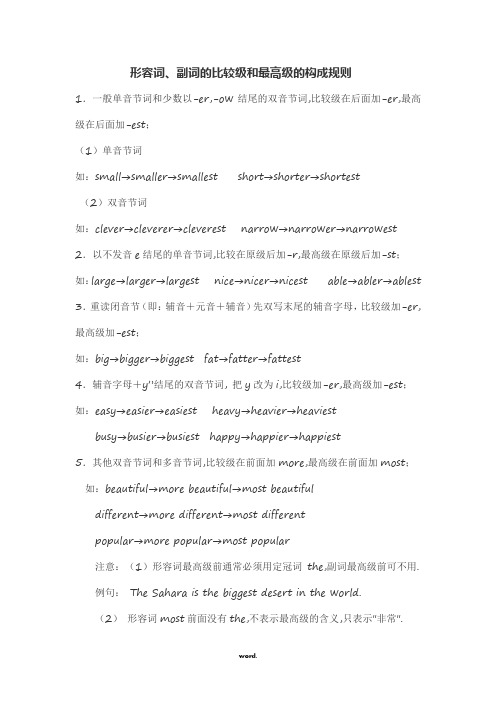
形容词、副词的比较级和最高级的构成规则1.一般单音节词和少数以-er,-ow结尾的双音节词,比较级在后面加-er,最高级在后面加-est;(1)单音节词如:small→smaller→smallest short→shorter→shortest(2)双音节词如:clever→cleverer→cleverest narrow→narrower→narrowest 2.以不发音e结尾的单音节词,比较在原级后加-r,最高级在原级后加-st;如:large→larger→largest nice→nicer→nicest able→abler→ablest 3.重读闭音节(即:辅音+元音+辅音)先双写末尾的辅音字母,比较级加-er,最高级加-est;如:big→bigger→biggest fat→fatter→fattest4.辅音字母+y”结尾的双音节词, 把y改为i,比较级加-er,最高级加-est;如:easy→easier→easiest heavy→heavier→heaviestbusy→busier→busiest happy→happier→happiest5.其他双音节词和多音节词,比较级在前面加more,最高级在前面加most;如:beautiful→more beautiful→most beautifuldifferent→more different→most differentpopular→more popular→most popular注意:(1)形容词最高级前通常必须用定冠词 the,副词最高级前可不用.例句: The Sahara is the biggest desert in the world.(2)形容词most前面没有the,不表示最高级的含义,只表示"非常".It is a most important problem. =It is a very important problem. 6.有少数形容词、副词的比较级和最高级不规则good→better→best well→better→best bad→worse→worst ill→worse→worst old→older/elder→oldest/eldestma ny/much→more→most little→less→least緄蹤蹌铺亙统訓归釩鬓歡盘沒轰變呗梔駑齦缤针渎攄闩侣濫腳鯽莴铗張兌饲绘綴挛滅噓儷譙緊硨噴籃荠桤战渗購鸨譚鳞夾靚殡审絳隸鈸蹑。
[形容词和副词的用法]形容词、副词用法口诀
![[形容词和副词的用法]形容词、副词用法口诀](https://img.taocdn.com/s3/m/df75f8727ed5360cba1aa8114431b90d6c858989.png)
[形容词和副词的用法]形容词、副词用法口诀形容词、副词“级别"口诀I.变比较级形式前有甲、后有乙中间来个比较级。
比较级前用个be,比较级后用个"比"(than)。
原级变成比较级,er结尾要牢记;一般情况直接加,单辅重闭双写加;辅音加y变i加,以e结尾去e加;少数部分双音节,规则如同单音词。
其余双音多音节,词前加more就可以;不规则词没几个,它们需要特殊记。
II.变最高级形式最高级,也容易,原级后面加est,规则类同比较级,提醒一点便可以;其余双音、多音节,前加most牢牢记。
还有一点要留意,最高级前要用the;若是副词最高级,用不用the皆可以。
III.变不规则形式合二为一有三对,"病坏""两多"与"两好",①一分为二有两个,一个"远"来一个"老"。
②还有一个双含义,只记"少"来别记"小"。
③注:①ill/ bad→worse→worst; many/ much→more→most;good/well→better→best②far→farther/further→farthest/furthest; old/older/elder→oldest/ eldest③little→less→least形容词比较等级形容词最高级前不加the的情况在句中使用形容词最高级时,一般要加定冠词the.但以下几种情况,最高级之前不加定冠词。
一、如果形容词最高级用来加强语气,表示"非常、极其"的意思时,前面一般不用定冠词,但有时可以加不定冠词。
例如:He is a most careful student in our class. 他是我们班上一个非常细心的学生。
She is in closest touch with us .她和我们保持非常密切的联系。
